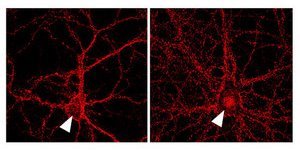May 25, 2007 Research Highlight Biology
Exploring new pathways leading to gene expression in the brain
Recent work may help explain how the brain reacts to exposure to unfamiliar environments
 Figure 1: In cultured hippocampal neurons, β-catenin (red) can be detected only at synapses (left). After stimulation with glutamate (right), β-catenin is also observed in the nucleus (indicated by arrowhead). © Neuron/Elsevier/53/390 (2007)
Figure 1: In cultured hippocampal neurons, β-catenin (red) can be detected only at synapses (left). After stimulation with glutamate (right), β-catenin is also observed in the nucleus (indicated by arrowhead). © Neuron/Elsevier/53/390 (2007)
Researchers have identified a signal transmitted within the brains of mice placed within novel surroundings. Neuronal excitements triggered by stimuli such as encounters with unfamiliar settings activate gene expression in nuclei, the cellular compartments where genes are located. Gene expression is suggested to play an important role in acquiring new memories of environments.
Kentaro Abe and Masatoshi Takeichi from the RIKEN Center for Developmental Biology in Kobe set out to trace the steps linking neuronal stimulation with gene expression. Their work appears in a recent issue of Neuron1.
To mimic brain stimulation, the researchers used glutamate, an amino acid that excites neurons by binding to receptors displayed on the neuronal surface. Unexpectedly, glutamate stimulation resulted in truncation of β-catenin, a component of cadherin–catenin adhesion complex that physically sticks two neurons together at synapses, or gaps between neurons. Calpain, a protease enzyme controlled by glutamate, was responsible for cleaving β-catenin.
β-catenin plays essential roles in two distinct cell functions, specifically cell-cell adhesion as a component of the cadherin–catenin adhesion complex, and regulation of gene expression as a component of the Wnt signaling system. Wnt proteins send signals through receptors expressed on the surface of multiple cell types in diverse organisms. These signals culminate to stabilize β-catenin, by halting its truncation, and influence myriad biological processes including the immune cell development and cellular transformation. However, in mature neurons, although β-catenin acting in the cadherin–catenin complex was known to regulate the formation or the function of synapses, whether β-catenin functions as a regulator of gene expression was not fully known.
The pair next sought to determine if, like the intact β-catenin in other cell types, these β-catenin fragments were competent to activate gene expression in neurons. After glutamate stimulation, the truncated β-catenin proteins migrated into the nuclei (Fig. 1). Within the nucleus, the fragments worked with established β-catenin partner proteins to drive production of known β-catenin–responsive genes.
Lastly, the researchers investigated whether calpain-mediated cleavage of β-catenin occurs within the brains of live mice. Like glutamate, exposure to an unfamiliar environment stimulated calpain-mediated production of β-catenin fragments, and activated the gene expression in neurons located in the brains of live mice.
“Identification of the full spectrum of genes regulated by calpain-mediated β-catenin cleavage may be the subject of later investigation,” says Abe. “As some mood stabilizing drugs can alter the cellular amounts of β-catenin, and some neurological disorders are associated with defective calpain activity, these findings may hold therapeutic relevance.”
References
- 1. Abe, K. & Takeichi, M. NDMA-receptor activation induces calpain-mediated β-catenin cleavages for triggering gene expression. Neuron 53, 387–397 (2007). 10.1016/j.neuron.2007.01.016
